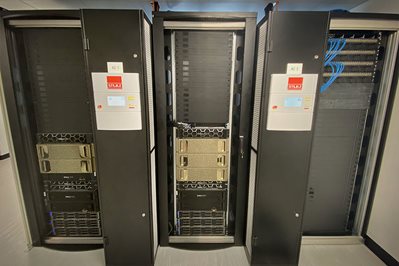Artificial Intelligence Service
NEODAAS has a team of Artificial Intelligence (AI) and Machine Learning (ML) experts that can consult, advise and provide support on the development of AI workflows and tools for Earth Observation. Coupled with access to NEODAAS data services and the support we can provide, this aids researchers in applying state-of-the-art AI solutions and ML approaches to Earth observation.
To facilitate application of Machine Learning (ML) and Artificial intelligence (AI), NEODAAS offer an AI service comprising training, support from data scientists and access to a large Graphics Processing Unit (GPU) cluster.
Our AI/ML experts can provide support in:
AI Development
NEODAAS regularly receive requests from users to develop specific AI models or approaches to suit bespoke problems. Users can contact us to discuss the individual task they are trying to achieve, and we can develop a tailored ML pipeline to suit the task.
AI Support
NEODAAS can support users through sharing knowledge and expertise, to discuss the best AI approaches and technologies that should be used to solve a given problem. This can be advice or practical support in implementing or optimising code.
AI Infrastructure
We can support users by providing supported access to the Massive GPU (Graphics Processing Unit) Cluster for Earth Observation (MAGEO). This High Performance Computing (HPC) facility allows users to prototype their AI approaches, and we provide support to optimise code and models for scaling up and running on larger datasets, or on multiple cores. This may include porting code to run on other infrastructure, for example, national (HPC) facilities.
Watch our video
The video below gives an outline of the AI services and capability of the brand new, state-of-the-art MAGEO cluster available through NEODAAS:
NEODAAS AI and ML Experts
The NEODAAS team comprises data scientists with expertise in applying AI and ML algorithms to Earth Observation data. We will help with a wide range of tasks ensuring you are able to apply the most appropriate method for your research in the most efficient way, including:
- Selection of most appropriate EO datasets and any necessary pre-processing.
- Advice on AI/ML algorithms and model selection and optimisation for to your specific application.
- Strategies for best use of in situ and other training data, including data augmentation.
- Large-scale training and application of AI models over large EO data archives, comprising 100s of TB, to produce output products.
Training
We regularly run or contribute to training sessions and are able to offer one-to-one training as part of the AI service. For details of previous courses we have run and future opportunities see the
training page and to discuss your training needs in more detail then please contact:
helpdesk@neodaas.ac.uk.
MAGEO
The MAssive GPU Cluster for Earth Observation (MAGEO) was funded through a NERC transformational capital bid and became operational at the end of 2020.
Hardware
The cluster is built around 5 NVIDIA DGX-1 MaxQ nodes, providing a total of 204,800 CUDA cores. The special edition NVIDIA DGX-1 MaxQ nodes are a more energy efficient version using only 50% of the power of the standard DGX-1 while still delivering 80% of the capacity. Each DGX-1 has 40,960 CUDA cores, 40 Intel Xeon 2.2 GHz cores, 512 GB system memory. The cluster has a dedicated 500 TB of fast Lustre storage as well as being able to access satellite data stored on the existing file system at PML, which has over 6 PB of storage.
Software
MAGEO is built around the following core technologies:
- JupyterHub - providing an easy method of accessing MAGEO from within a browser through the MAGEOHub instance.
- Docker and Singularity - to provide environments with the latest Deep Learning and GPU optimised libraries (e.g. TensorFlow, PyTorch, RAPIDS), which are portable across different platforms.
- SLURM - for large-scale training and inference jobs by NEODAAS.
MAGEOHub is the method used for external access to MAGEO as this provides an environment with common packages set up but that is easily customisable to meet more specific requirements.

How to Access
There are two ways to access the NEODAAS AI service; through a NERC grant or direct access.
If you would like support from NEODAAS as part of a grant, then you must add it as a NERC Service & Facility as part of the JeS form. Please
contact NEODAAS to discuss your requirements and for a technical assessment.
If you do not have a NERC grant but are eligible for NERC funding then you can access MAGEO through a direct access application which is sent for peer review.
The application form is available to download here. We may also provide access to MAGEOHub to go through our training material and runs small scale tests prior to submission of an application so please contact us to discuss this.